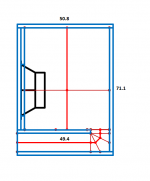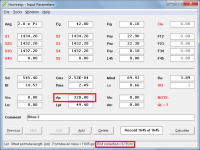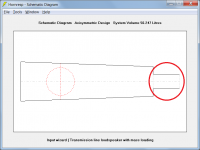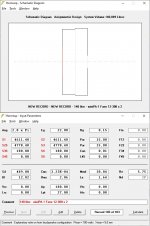Right, and the mass loading stems from the ports air mass, correct?Technically it's a OD-MLTL
Exploitation of box modes. A standard ported box doesn't do this.what designcriteras needs to met for calling it a TL,
Right, and the mass loading stems from the ports air mass, correct?

Exploitation of box modes. A standard ported box doesn't do this.
Right, it must be a high enough aspect ratio for 1/4 WL pipe modes to damp the vent enough to make a measurable difference to a lower Fb, so varies based on desired tuning, otherwise it's presumed to have a ~uniform particle density.
Resonances of open air columns
If you adjust for the end correction and set QL to lossless as shown in the attachments, the results become effectively identical, with the fundamental frequency being 42.4 Hz in each case.
Yup, but it does raise the question of which of those two models will more accurately predict the response of the attached system, without having to adjust any of the dimensions involved. I do know that the standard OD model did a very good job of predicting the Fb for both my POC6 and my "Boom Unit" builds.
How is the end correction calculated, btw?
Attachments
How is the end correction calculated, btw?
dia = 2 * Sqrt(Ap / Pi) <---- Port tube diameter (m)
Lpt1 = Lpt + 0.306 * dia <---- Port tube length plus unflanged inlet end correction (m)
it does raise the question of which of those two models will more accurately predict the response of the attached system
The second (bass reflex) model will more accurately predict the results because it takes vented-box enclosure losses (default QL = 7) and the port tube internal end correction into account (the internal end of the port tube is assumed to be un-flanged).
Lpt1 = Lpt + 0.306 * dia <---- Port tube length plus unflanged inlet end correction (m)
Hornresp actually uses the following formula for the internal unflanged end correction length, which gives effectively the same result as the one above.
EC = 0.1952 * Pi * Rp
Where EC is the end correction length and Rp is the port tube radius.
In the previous example, Ap = 320.00 sq cm
EC = 0.1952 * Pi * Sqrt(320 / Pi) = 6.19 cm (to two decimal places)
Attachments
and the mass loading stems from the ports air mass, correct?
Correct.
Attachments
David, for those of us that are mentally challenged enough to not understand all that fancy wizardry you've put into the more recent revisions, but instead just want to hammer some digits directly into the designated fields.
I am having some difficulties just adding the port information like you did, it just becomes an open hole?
Obviously I'm doing something wrong, but I am unable to understand exactly what that would be.
I am having some difficulties just adding the port information like you did, it just becomes an open hole?
Obviously I'm doing something wrong, but I am unable to understand exactly what that would be.
Attachments
Anyone got any tips? I tried it in a number of different "driver entry point" settings etc.
Could well be that I need to revise my workflow, I just really like to tab around and use the numpad. No need to move the hand to the mouse and back constantly, fiddling with sliders that are a pain to get "just so". Numpad FTW!
Hotkeys and alt+tab to switch to calculators or spec sheets, everything relevant, crucial settings and parameters on hornresp out in the open on that input window, it's great!
Sidenote:
I'm not *that* old (39 soon), but so many new programs with fancy GUI have those wizard things that make me fumble about needlessly (IMO) and click "next" more times than putting in relevant information (not talking about hornresp here, just in general).
Is it just me?
Could well be that I need to revise my workflow, I just really like to tab around and use the numpad. No need to move the hand to the mouse and back constantly, fiddling with sliders that are a pain to get "just so". Numpad FTW!
Hotkeys and alt+tab to switch to calculators or spec sheets, everything relevant, crucial settings and parameters on hornresp out in the open on that input window, it's great!
Sidenote:
I'm not *that* old (39 soon), but so many new programs with fancy GUI have those wizard things that make me fumble about needlessly (IMO) and click "next" more times than putting in relevant information (not talking about hornresp here, just in general).
Is it just me?
I am having some difficulties just adding the port information like you did, it just becomes an open hole?
Specify the loudspeaker configuration as OD not Nd, and also specify a closed mouth.
Last edited:
Hornresp actually uses the following formula for the internal unflanged end correction length, which gives effectively the same result as the one above.
EC = 0.1952 * Pi * Rp
Where EC is the end correction length and Rp is the port tube radius.
In the previous example, Ap = 320.00 sq cm
EC = 0.1952 * Pi * Sqrt(320 / Pi) = 6.19 cm (to two decimal places)
Thanks for correcting. Thought I was safe taking what the HR akabak export file comment said it was (knew better than to not qualify that when I posted, too, but always the slow-learner with me...)
Is it just me?
Outstanding geezer-rant for a young person. Warms my heart to know it's not just us chafing.
Not near a computer right this minute, but I like to run the same sim as ND and OD to check for discrepancies. It's just numbers and default is front firing port which is my personal preference anyway so... Low frequency should be correct at least, will just add this as a single step further at the end. Thanks!Specify the loudspeaker configuration as OD not Nd, and also specify a closed mouth.
Thanks! Warms my heart to be one virtual step further away from those blighted millennials.Outstanding geezer-rant for a young person.
Thought I was safe taking what the HR akabak export file comment said it was
Many thanks for bringing this to my attention. At some stage I must have tweaked the formula used to calculate the unflanged inlet end correction, but overlooked amending the AkAbak script description to suit. This oversight will be rectified in the next update.
- Home
- Loudspeakers
- Subwoofers
- Vented vs TL...



